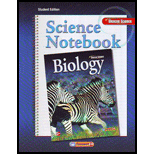
Concept explainers
To fill:
The correct term according to the given definitions.
Introduction:
The oceans and the water bodies are divided into different region depending on the distribution of the
Answer to Problem 3MI
The given blanks can be filled as follows:
| S. no. | Correct term |
| 1 | Profundal zone |
| 2 | Intertidal zone |
| 3 | Aphotic zone |
| 4 | Photic zone |
| 5 | Abyssal zone |
| 6 | Wetlands |
| 7 | Littoral zone |
| 8 | Estuary |
| 9 | Limnetic zone |
| 10 | Benthic zone |
| 11 | Sediment |
| 12 | Planktons |
Explanation of Solution
Profundal zone: The profundal zone is referred to the deep zone of the water body such as lake or pond. The water here is generally freestanding and there is almost no penetration of the light.
Intertidal zone: The region where the land and water meet is known as intertidal zone. It is the region between the lowest tides and the highest tides. Sometimes it is also called foreshore and seashore.
Aphotic zone: Aphotic means no light, so, the aphotic zone is the region, where the sunlight is not able to penetrate. It is found below 200 meters of an open waterbody.
Photic zone: the photic zone is the region, where the sunlight is available. In general, the photic zone is around 200 meters. Below 200 meters, the sunrays cannot penetrate in the water.
Abyssal zone: The abyssal zone of the ocean is deepest. This region is devoid of any kind of light and the organism living here are adapted to low lights.
Wetlands: The wetlands are the area, in which the soil is covered with the water, due to the presence of nearby large bodies. These regions are saturated with water, which supports the growth of the aquatic plants.
Littoral zone: The littoral zone of a water body is referred to the region, where the water is present near the land. These regions are shallow and supports growth of many aquatic plants.
Estuary: It is a water body where one or more river joins the sea. The estuary is a partially covered body and here, the fresh water from the river and the salty water from the sea gets mixed.
Limnetic zone: The limnetic zone is referred to the zone of a water body, which is open and away from the land, here the water is generally undisturbed and this supports the growth of the planktons.
Benthic zone: the benthic zone is the region, which is present near the solid masses. It includes the shore and the ocean floor. It consists of sediments, sand, slit and all the dead remains of the organism present in the sea.
Sediments: The sediments are the solid material that are present in the deposited form in the water body. These sediments in the water may come with the wind, glaciers, pollutants, etc.
Planktons: The planktons are the microscopic free-floating autotrophs. They are one of the major sources of food for smaller aquatic organisms and one of the prime producers in the aquatic ecosystem.
Additional Science Textbook Solutions
Genetic Analysis: An Integrated Approach (2nd Edition)
Microbiology with Diseases by Taxonomy (5th Edition)
Concepts of Genetics (11th Edition)
Becker's World of the Cell (9th Edition)
Microbiology: An Introduction
Brock Biology of Microorganisms (15th Edition)
 Human Anatomy & Physiology (11th Edition)BiologyISBN:9780134580999Author:Elaine N. Marieb, Katja N. HoehnPublisher:PEARSON
Human Anatomy & Physiology (11th Edition)BiologyISBN:9780134580999Author:Elaine N. Marieb, Katja N. HoehnPublisher:PEARSON Biology 2eBiologyISBN:9781947172517Author:Matthew Douglas, Jung Choi, Mary Ann ClarkPublisher:OpenStax
Biology 2eBiologyISBN:9781947172517Author:Matthew Douglas, Jung Choi, Mary Ann ClarkPublisher:OpenStax Anatomy & PhysiologyBiologyISBN:9781259398629Author:McKinley, Michael P., O'loughlin, Valerie Dean, Bidle, Theresa StouterPublisher:Mcgraw Hill Education,
Anatomy & PhysiologyBiologyISBN:9781259398629Author:McKinley, Michael P., O'loughlin, Valerie Dean, Bidle, Theresa StouterPublisher:Mcgraw Hill Education, Molecular Biology of the Cell (Sixth Edition)BiologyISBN:9780815344322Author:Bruce Alberts, Alexander D. Johnson, Julian Lewis, David Morgan, Martin Raff, Keith Roberts, Peter WalterPublisher:W. W. Norton & Company
Molecular Biology of the Cell (Sixth Edition)BiologyISBN:9780815344322Author:Bruce Alberts, Alexander D. Johnson, Julian Lewis, David Morgan, Martin Raff, Keith Roberts, Peter WalterPublisher:W. W. Norton & Company Laboratory Manual For Human Anatomy & PhysiologyBiologyISBN:9781260159363Author:Martin, Terry R., Prentice-craver, CynthiaPublisher:McGraw-Hill Publishing Co.
Laboratory Manual For Human Anatomy & PhysiologyBiologyISBN:9781260159363Author:Martin, Terry R., Prentice-craver, CynthiaPublisher:McGraw-Hill Publishing Co. Inquiry Into Life (16th Edition)BiologyISBN:9781260231700Author:Sylvia S. Mader, Michael WindelspechtPublisher:McGraw Hill Education
Inquiry Into Life (16th Edition)BiologyISBN:9781260231700Author:Sylvia S. Mader, Michael WindelspechtPublisher:McGraw Hill Education





